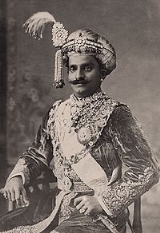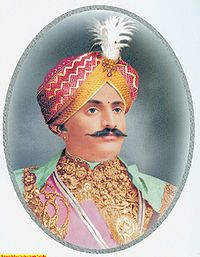
Chamaraja Wodeyar
Encyclopedia
Chamaraja Wadiyar X (1863–94) was the ruling Maharaja
of Mysore
between 1881 and 1894.
 Chamaraja was born at the old palace in Mysore on February 22, 1863, as the third son of Sardar Chikka Krishnaraj Urs, of the Bettada-Kote branch of the ruling clan. His father died about a week before Chamaraja's birth. His mother, Rajkumari Sri Puta Ammani Avaru, was the eldest daughter of Krishnaraja Wodeyar III, the then Maharaja of Mysore. Following the failure of heirs male, Krishnaraja Wadiyar decided to adopt as heir his grandson, Chamaraja. This was done on June 18, 1865 and was recognized by the British government of India on 16 April 1867.
Chamaraja was born at the old palace in Mysore on February 22, 1863, as the third son of Sardar Chikka Krishnaraj Urs, of the Bettada-Kote branch of the ruling clan. His father died about a week before Chamaraja's birth. His mother, Rajkumari Sri Puta Ammani Avaru, was the eldest daughter of Krishnaraja Wodeyar III, the then Maharaja of Mysore. Following the failure of heirs male, Krishnaraja Wadiyar decided to adopt as heir his grandson, Chamaraja. This was done on June 18, 1865 and was recognized by the British government of India on 16 April 1867.
Krishnaraja Wadiyar III died on 27 March 1868, and Chamaraja Wadiyar ascended the throne at the royal palace, Mysore, on September 23, 1868. However, since 1831, the kingdom of Mysore had been under the direct administration of the British Raj
, who had deposed Krishnaraja Wadiyar on allegations of misrule. Later, the privy council of the United Kingdom ordered the reversal of the British East India Company
's decision to annex Mysore. By the "Rendition of 1881," the princely state of Mysore was reconstitited and restored to the Wadiyar dynasty. Chamaraja Wadiyar was groomed by the British to take charge of the administration. He was handed the reins of governance in 1881.
and thereby on the present day India
n state of Karnataka
.
He instituted the Representative Assembly of Mysore state in 1881. This was the first modern, democratic legislative institution of its kind in princely India. He sponsored the famous journey of Swami Vivekananda
to Chicago
in 1893. He gave primacy to women's education and founded the Kannada Bashojjivini School. He gave a fillip to the industrialisation of the Kingdom of Mysore by instituting several industrial schools and conducting the annual Dasara Industrial Exhibition. He facilitated the founding of Agricultural Banks to help finance farmers and initiated Life Insurance for government employees.
Many of the most famous landmarks of Mysore and Bangalore
owe their existence to him. Prominent among these are:
 Chamaraja Wadiyar was a great patron of arts and music, his court boasted of artists like Veena Subbanna, Veena Seshanna, K. Vasudevacharya, Veena Padmanabiah, Mysore Karigiri Rao and Bidaram Krishnappa among others.
Chamaraja Wadiyar was a great patron of arts and music, his court boasted of artists like Veena Subbanna, Veena Seshanna, K. Vasudevacharya, Veena Padmanabiah, Mysore Karigiri Rao and Bidaram Krishnappa among others.
The Maharaja was a violin virtoso himself and used to provide accompaniment daily to Veena Subbanna's vocal and Veena Sheshanna's veena performances. His favourite kriti
's included "Sujana Jeevana" and "Lavanya Rama." He was also a connaisseur of Javali's (Kritis and Javalis are genres of Carnatic music
).
, daughter of an Arasu of Kalale, a prominent nobleman of Mysore state. They had four sons and three daughters, of whom the following survived to adulthood:
Chamaraja Wodeyar died of diphtheria
, in Calcutta, on December 28, 1894, aged 31. He was succeeded by his 10-year-old son, Krishnaraja Wodeyar IV. His wife, Maharani Kempa Nanjammani Vani Vilasa Sannidhana Avaru, served as regent of Mysore during the minority of their son.
Sri
Sir
Chamaraja Wadiyar, GCSI, Maharaja of Mysore.
Maharaja
Mahārāja is a Sanskrit title for a "great king" or "high king". The female equivalent title Maharani denotes either the wife of a Maharaja or, in states where that was customary, a woman ruling in her own right. The widow of a Maharaja is known as a Rajamata...
of Mysore
Kingdom of Mysore
The Kingdom of Mysore was a kingdom of southern India, traditionally believed to have been founded in 1399 in the vicinity of the modern city of Mysore. The kingdom, which was ruled by the Wodeyar family, initially served as a vassal state of the Vijayanagara Empire...
between 1881 and 1894.
Adoption and accession

Krishnaraja Wadiyar III died on 27 March 1868, and Chamaraja Wadiyar ascended the throne at the royal palace, Mysore, on September 23, 1868. However, since 1831, the kingdom of Mysore had been under the direct administration of the British Raj
British Raj
British Raj was the British rule in the Indian subcontinent between 1858 and 1947; The term can also refer to the period of dominion...
, who had deposed Krishnaraja Wadiyar on allegations of misrule. Later, the privy council of the United Kingdom ordered the reversal of the British East India Company
British East India Company
The East India Company was an early English joint-stock company that was formed initially for pursuing trade with the East Indies, but that ended up trading mainly with the Indian subcontinent and China...
's decision to annex Mysore. By the "Rendition of 1881," the princely state of Mysore was reconstitited and restored to the Wadiyar dynasty. Chamaraja Wadiyar was groomed by the British to take charge of the administration. He was handed the reins of governance in 1881.
Reign
Chamaraja Wadiyar was the 23rd Maharaja of Mysore. Although his reign proved to be a brief one, he left an indelible mark on the Kingdom of MysoreKingdom of Mysore
The Kingdom of Mysore was a kingdom of southern India, traditionally believed to have been founded in 1399 in the vicinity of the modern city of Mysore. The kingdom, which was ruled by the Wodeyar family, initially served as a vassal state of the Vijayanagara Empire...
and thereby on the present day India
India
India , officially the Republic of India , is a country in South Asia. It is the seventh-largest country by geographical area, the second-most populous country with over 1.2 billion people, and the most populous democracy in the world...
n state of Karnataka
Karnataka
Karnataka , the land of the Kannadigas, is a state in South West India. It was created on 1 November 1956, with the passing of the States Reorganisation Act and this day is annually celebrated as Karnataka Rajyotsava...
.
He instituted the Representative Assembly of Mysore state in 1881. This was the first modern, democratic legislative institution of its kind in princely India. He sponsored the famous journey of Swami Vivekananda
Swami Vivekananda
Swami Vivekananda , born Narendranath Dutta , was the chief disciple of the 19th century mystic Ramakrishna Paramahansa and the founder of the Ramakrishna Math and the Ramakrishna Mission...
to Chicago
Chicago
Chicago is the largest city in the US state of Illinois. With nearly 2.7 million residents, it is the most populous city in the Midwestern United States and the third most populous in the US, after New York City and Los Angeles...
in 1893. He gave primacy to women's education and founded the Kannada Bashojjivini School. He gave a fillip to the industrialisation of the Kingdom of Mysore by instituting several industrial schools and conducting the annual Dasara Industrial Exhibition. He facilitated the founding of Agricultural Banks to help finance farmers and initiated Life Insurance for government employees.
Many of the most famous landmarks of Mysore and Bangalore
Bangalore
Bengaluru , formerly called Bengaluru is the capital of the Indian state of Karnataka. Bangalore is nicknamed the Garden City and was once called a pensioner's paradise. Located on the Deccan Plateau in the south-eastern part of Karnataka, Bangalore is India's third most populous city and...
owe their existence to him. Prominent among these are:
- Bangalore Palace
- Lalbagh Glass House
- Oriental Research Institute MysoreOriental Research Institute MysoreThe Oriental Research Institute at Mysore, India is a research institute which collects, exhibits, edits and publishes rare manuscripts in both Sanskrit and Kannada. Formerly it was known as the Oriental Library....
, established in 1891 - Maharaja College, Mysore
- Maharaja's Sanskrit School
- Government Office
- Lansdowne Bazaar
- Dufferin Tower
- Mysore Zoo
- Fern Hill Palace (Ooty).
Patronage

The Maharaja was a violin virtoso himself and used to provide accompaniment daily to Veena Subbanna's vocal and Veena Sheshanna's veena performances. His favourite kriti
Kriti
-Structure:Kritis typically contain three parts#Pallavi. This is the equivalent of a refrain in Western music.#Anupallavi. The second verse, which is sometimes optional....
's included "Sujana Jeevana" and "Lavanya Rama." He was also a connaisseur of Javali's (Kritis and Javalis are genres of Carnatic music
Carnatic music
Carnatic music is a system of music commonly associated with the southern part of the Indian subcontinent, with its area roughly confined to four modern states of India: Andhra Pradesh, Karnataka, Kerala, and Tamil Nadu...
).
Family
In May 1878, Chamaraja Wadiyar married Vani Vilasa Sannidhana Kempananja Ammani AvaruMaharani Kempa Nanjammani Vani Vilasa Sannidhana
Maharani Kempa Nanjammani Vani Vilasa Sannidhana was the wife of Maharaja Chamaraja Wodeyar IX and mother of Maharaja Krishnaraja Wodeyar IV.Maharani Kempananjammanni of Vani Vilasa Sannidhana [in full] occupies as high a place as any in the annals of Mysore history...
, daughter of an Arasu of Kalale, a prominent nobleman of Mysore state. They had four sons and three daughters, of whom the following survived to adulthood:
- Krishnaraja Wadiyar IV, succeeded his father as Maharaja of Mysore.
- Prince Kanteerava Narasimharaja WadiyarKanteerava Narasimharaja WadiyarYuvaraja Sri Sir Kanteerava Narasimharaja Wadiyar, GCIE , was the heir apparent of the princely state of Mysore from 1895 until his death in 1940.-Biography:...
, father of Jayachamaraja Wodeyar - Princess Jayalakshmi Ammani, (1881–1924), married in 1897, her youngest maternal uncle, Sardar Kantaraj Urs, KCIE, CSI, Dewan of Mysore between 1919-1922. Manasa Gangotri - Post graduate centre of University of Mysore with the Bungalow Jayalakshammani Vilas Mansion was built as her Residence.
- Princess Krishnaraja Ammani, (1883–1904), married in 1896, Col. Devaraj Urs, CIE, MVO, an army officer and the Arasu of Bagle in Mysore state. She and her three daughters died of Tuberculosis> Royal family built the Princess Krishnajammanni sanitorium in her memory.
- Princess Chaluvaja Ammani (1886–1934), married in 1900, Sardar M. Lakshmikanta Raj Urs, a nobleman of Mysore state. Cheluvamba Mansion in Mysore, which presently houses the CFTRI, was built as her residence. There is also a maternity hospital and park named after her.
Chamaraja Wodeyar died of diphtheria
Diphtheria
Diphtheria is an upper respiratory tract illness caused by Corynebacterium diphtheriae, a facultative anaerobic, Gram-positive bacterium. It is characterized by sore throat, low fever, and an adherent membrane on the tonsils, pharynx, and/or nasal cavity...
, in Calcutta, on December 28, 1894, aged 31. He was succeeded by his 10-year-old son, Krishnaraja Wodeyar IV. His wife, Maharani Kempa Nanjammani Vani Vilasa Sannidhana Avaru, served as regent of Mysore during the minority of their son.
Title
His official full name was also His Highness MaharajaMaharaja
Mahārāja is a Sanskrit title for a "great king" or "high king". The female equivalent title Maharani denotes either the wife of a Maharaja or, in states where that was customary, a woman ruling in her own right. The widow of a Maharaja is known as a Rajamata...
Sri
Sri
Sri , also transliterated as Shri or Shree or shre is a word of Sanskrit origin, used in the Indian subcontinent as polite form of address equivalent to the English "Mr." in written and spoken language, or as a title of veneration for deities .-Etymology:Sri has the root meaning of radiance, or...
Sir
Sir
Sir is an honorific used as a title , or as a courtesy title to address a man without using his given or family name in many English speaking cultures...
Chamaraja Wadiyar, GCSI, Maharaja of Mysore.

